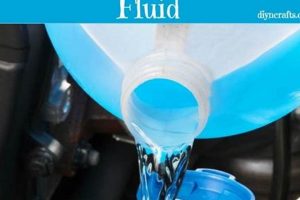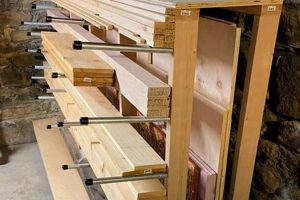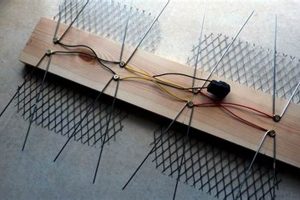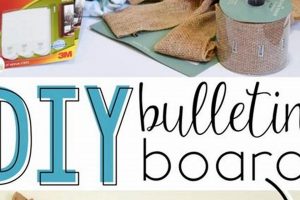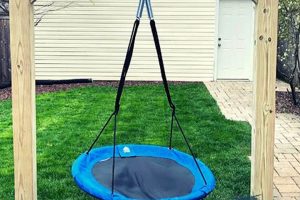The act of personally installing ceramic, porcelain, or stone surfaces within a shower enclosure, without professional assistance, represents a significant home improvement undertaking. This process encompasses tasks such as waterproofing, mortar application, tile setting, and grout sealing, all completed by the homeowner or a non-professional individual. An example includes a homeowner choosing and installing subway tiles in their shower, completing all stages from substrate preparation to final sealing.
This approach to bathroom renovation offers considerable cost savings compared to hiring a contractor. Beyond the financial advantages, it allows for a high degree of personalization and control over the aesthetic outcome. Historically, tiling has been a skilled trade, but the availability of resources and simplified materials has made it increasingly accessible to a wider audience, fostering a rise in amateur participation.
The following article will delve into the essential steps involved in this type of project, covering topics such as planning and preparation, material selection, tiling techniques, waterproofing, and potential pitfalls to avoid, providing a comprehensive guide for successful execution.
DIY Tile Shower
Successfully completing a tile installation in a shower requires meticulous planning and precise execution. The following tips offer guidance for achieving professional results and ensuring longevity.
Tip 1: Proper Substrate Preparation: The foundation for any successful tiling project is a stable and waterproof substrate. Cement board is generally recommended over drywall in wet areas. Ensure the substrate is level, clean, and free from debris before proceeding.
Tip 2: Accurate Measurement and Layout: Precise measurement is critical to avoid uneven tile cuts and unsightly layouts. Plan the tile layout beforehand, identifying the focal point and considering where cuts will be most visually appealing. Using a laser level can greatly improve accuracy.
Tip 3: High-Quality Waterproofing: Inadequate waterproofing can lead to significant structural damage. Utilize a liquid waterproofing membrane or a sheet membrane system, carefully following the manufacturer’s instructions. Pay particular attention to corners and seams, which are prone to leaks.
Tip 4: Thin-Set Mortar Selection: Choose a thin-set mortar specifically designed for shower applications. Consider the type of tile being used (e.g., porcelain, ceramic, natural stone) and select a mortar that is compatible. Use a notched trowel of the appropriate size to ensure proper mortar coverage.
Tip 5: Grout Selection and Application: Select a grout that is resistant to mold and mildew. Epoxy grout offers superior stain and water resistance compared to cement-based grout, although it can be more challenging to apply. Follow the manufacturer’s instructions carefully to avoid haze and discoloration.
Tip 6: Sealing the Grout: After the grout has cured, apply a high-quality grout sealer to protect it from stains and water damage. Reapply the sealer periodically to maintain its effectiveness.
Tip 7: Ventilation Considerations: Proper ventilation is crucial to prevent moisture buildup and mold growth. Ensure the bathroom has an adequately sized exhaust fan and use it consistently after showering.
Implementing these tips can help ensure a durable, aesthetically pleasing, and water-resistant tile installation within a shower environment, minimizing the risk of future problems and maximizing the return on investment.
The following sections will provide more in-depth instructions and considerations regarding material selection, installation techniques, and troubleshooting common problems encountered during this endeavor.
1. Waterproofing membrane application
The application of a waterproofing membrane is a non-negotiable element in the successful execution of a do-it-yourself tile shower project. Its primary function is to prevent water penetration behind the tile assembly, which can lead to structural damage, mold growth, and costly repairs. The effectiveness of the membrane directly correlates to the longevity and health safety of the shower enclosure.
- Surface Preparation Prior to Application
Proper preparation of the substrate, typically cement board, is crucial. This involves ensuring the surface is clean, free of debris, and properly fastened. Any imperfections, such as screw holes or seams, must be addressed with appropriate patching compounds and waterproofing tape. Inadequate surface preparation compromises the membrane’s adhesion, potentially leading to water intrusion at vulnerable points.
- Selection of Waterproofing Membrane Type
Various waterproofing membranes are available, including liquid-applied membranes (e.g., RedGard, Hydro Ban) and sheet membranes (e.g., Kerdi). The selection depends on factors such as the substrate material, the size and complexity of the shower enclosure, and the installer’s familiarity with the product. Liquid-applied membranes require multiple coats and careful attention to application thickness, while sheet membranes offer a more consistent thickness but require precise cutting and overlapping.
- Proper Application Technique
Regardless of the membrane type chosen, meticulous application is essential. Liquid-applied membranes should be applied in thin, even coats, allowing sufficient drying time between coats. Sheet membranes must be carefully adhered to the substrate, ensuring complete coverage and watertight seams. Special attention must be paid to corners, pipe penetrations, and drain areas, which are common points of failure. Reinforcement fabrics or specialized sealants are often required to ensure watertight seals in these areas.
- Curing and Inspection
After application, the waterproofing membrane requires adequate curing time, as specified by the manufacturer. During the curing process, the membrane should be protected from physical damage and excessive moisture. Following curing, a thorough inspection is essential to identify any defects, such as pinholes, thin spots, or incomplete seams. Any identified defects must be repaired before proceeding with tile installation. A water test, involving plugging the drain and filling the shower pan with water, can be conducted to verify the integrity of the waterproofing system.
These facets underscore that the waterproofing membrane is not merely an optional step but a critical component of a do-it-yourself tile shower. Its proper application is directly linked to the structural integrity, hygiene, and lifespan of the installation. A failure in this area can negate all other efforts, resulting in significant remediation costs and health hazards.
2. Mortar and grout selection
The selection of appropriate mortar and grout is paramount to the success of any do-it-yourself tile shower project. These materials not only secure the tiles but also contribute significantly to the overall durability, water resistance, and aesthetic appeal of the finished shower.
- Mortar Type and Tile Compatibility
The type of mortar must be compatible with both the substrate and the tile material. For example, modified thin-set mortar is generally recommended for porcelain and ceramic tiles due to its enhanced bonding properties. Natural stone tiles, however, may require a specific type of modified thin-set designed to prevent staining. Incorrect mortar selection can lead to tile delamination, cracking, and water intrusion. Consider a homeowner installing heavy slate tiles with an unmodified thin-set; the resulting lack of adhesion could cause the tiles to fail over time, necessitating costly repairs.
- Grout Type and Environmental Considerations
Grout fills the spaces between tiles, preventing water from penetrating the substrate. Cement-based grouts are commonly used, but epoxy grouts offer superior water resistance, stain resistance, and durability, making them suitable for high-moisture environments like showers. Epoxy grouts, however, can be more challenging to apply. Using a dark-colored cement-based grout in a shower prone to mildew could lead to unsightly staining and require frequent cleaning, whereas an epoxy grout would mitigate this issue.
- Additive Selection for Enhanced Performance
Various additives can be incorporated into mortar and grout to enhance their performance characteristics. Latex additives can improve the flexibility and bond strength of mortar, reducing the risk of cracking. Grout sealers can provide an additional layer of protection against water and stain penetration. Failing to use a suitable additive, such as a crack suppression membrane under the mortar bed in an area prone to movement, can result in hairline cracks appearing in the grout lines shortly after installation.
- Color Coordination and Aesthetic Impact
Mortar and grout color significantly impacts the overall aesthetic of the tiled shower. Selecting a grout color that contrasts with the tile can create a bold, graphic look, while a matching grout color can provide a more seamless appearance. Consider a homeowner choosing a bright white grout with dark gray tiles; the high contrast would highlight the tile pattern, whereas a gray grout would blend the tiles together for a more uniform look. The ultimate choice should align with the desired aesthetic and the overall design of the bathroom.
Therefore, meticulous attention to mortar and grout selection is not merely a cosmetic consideration, but a critical factor determining the long-term performance and visual appeal of any do-it-yourself tile shower installation. Careful consideration of tile type, environmental conditions, performance requirements, and aesthetic goals ensures a successful and durable outcome.
3. Tile layout and cutting
The success of a “diy tile shower” hinges significantly on the planning and execution of tile layout and cutting. These processes are not merely aesthetic considerations but directly impact the structural integrity and water resistance of the shower enclosure. A poorly planned layout can result in an uneven distribution of tiles, requiring numerous small cuts that compromise the waterproofing layer. Incorrect cuts can lead to gaps and misalignments, creating pathways for water intrusion and subsequent mold growth. For instance, consider a shower floor where the tile layout does not account for the slope towards the drain. This necessitates complex and often imprecise cuts, increasing the risk of water pooling and eventual substrate damage. The selection of tile size and shape must, therefore, be carefully considered during the planning phase to minimize cutting requirements, especially in areas prone to water exposure.
Accurate cutting techniques are equally crucial. Utilizing appropriate tools, such as a wet saw for larger tiles and a tile nipper for intricate shapes, is essential for achieving clean and precise cuts. Improper cutting can result in chipped edges and uneven surfaces, detracting from the overall aesthetic and creating vulnerabilities in the grout lines. Furthermore, understanding the properties of different tile materials is vital. Porcelain tiles, for example, are denser and more challenging to cut than ceramic tiles, requiring specialized blades and techniques. Prior practice on scrap tiles is recommended to develop proficiency and minimize waste. The strategic placement of cut tiles in less visible areas, such as corners or near the shower floor, can further enhance the visual appeal and minimize the impact of any imperfections.
In summary, meticulous planning of tile layout and precise cutting techniques are fundamental to a successful “diy tile shower.” These aspects directly influence the water resistance, structural integrity, and overall aesthetic of the finished project. Overlooking or underestimating the importance of these steps can lead to costly repairs and compromised performance, underscoring the need for careful planning, appropriate tools, and a thorough understanding of tiling principles.
4. Substrate surface preparation
Proper substrate surface preparation is an indispensable prerequisite for a successful do-it-yourself tile shower installation. The substrate, which serves as the foundation for the tile assembly, directly influences the adhesion, water resistance, and longevity of the finished shower. Neglecting this crucial step can lead to tile delamination, water intrusion, and structural damage, negating the efforts invested in subsequent stages of the project.
- Cleaning and Degreasing
The initial step in substrate preparation involves thorough cleaning to remove any contaminants, such as dirt, dust, grease, or soap residue. These substances can interfere with the bonding of the thin-set mortar, leading to tile failure. For example, if a homeowner fails to remove residual soap scum from a previously tiled surface before applying new thin-set, the tiles may not adhere properly, eventually resulting in loose or cracked tiles.
- Leveling and Flattening
The substrate must be level and flat to ensure a uniform tile surface. Imperfections, such as humps or dips, can cause uneven tile placement and create stress points that lead to cracking. Self-leveling compounds or patching mortars can be used to correct minor irregularities. A substrate with significant unevenness, exceeding the tolerance of the thin-set mortar, can result in a finished shower floor that doesn’t drain properly, leading to water pooling and potential mold growth.
- Moisture Testing and Mitigation
In concrete substrates, moisture levels must be within acceptable limits to prevent adhesive failure and efflorescence. Moisture testing should be conducted using a calibrated moisture meter. If excessive moisture is detected, mitigation measures, such as the application of a moisture barrier, are necessary. Installing tile over a damp concrete slab without addressing the moisture issue can lead to blistering of the tile surface and eventual failure of the adhesive bond.
li>
- Priming and Sealing
Priming the substrate can improve the adhesion of the thin-set mortar and reduce its water absorption. Primers specifically designed for tile installations should be used, following the manufacturer’s instructions. Sealing the substrate can provide an additional layer of protection against water intrusion, particularly in areas prone to moisture exposure. Applying a suitable primer before thin-set application ensures a strong and durable bond between the tile and the substrate, enhancing the shower’s overall resistance to water damage and prolonging its lifespan.
The aforementioned facets of substrate surface preparation are not isolated steps but rather interconnected elements that contribute to the overall success of a do-it-yourself tile shower project. Proper execution of these steps ensures a solid foundation for the tile assembly, minimizing the risk of future problems and maximizing the longevity and aesthetic appeal of the finished shower. A well-prepared substrate is, therefore, an investment in the long-term performance and value of the installation.
5. Ventilation and drying time
The correlation between ventilation and drying time is critical in do-it-yourself tile shower construction. Insufficient ventilation extends drying periods for thin-set mortar, grout, and waterproofing membranes. This prolonged moisture exposure can compromise the structural integrity of these materials, potentially leading to premature failure. For instance, if a shower is tiled in a poorly ventilated bathroom, the prolonged drying time for the grout can result in efflorescence, a white, powdery residue on the grout surface, indicating mineral salt migration due to trapped moisture. Such a scenario necessitates remedial action and can detract from the shower’s aesthetic appeal.
Adequate ventilation facilitates the evaporation of moisture, allowing the mortar and grout to cure properly and achieve their designed strength and water resistance. Moreover, shortened drying times reduce the risk of mold and mildew growth, particularly in the enclosed environment of a shower. Consider a newly tiled shower lacking an operational exhaust fan; the elevated humidity levels create a breeding ground for microorganisms, potentially leading to unsanitary conditions and necessitating costly mold remediation. Furthermore, improper drying can lead to uneven curing, affecting the color consistency of the grout and the overall appearance of the tiled surface.
In summary, appropriate ventilation during and after a tile shower project is not merely a suggestion but a fundamental requirement for ensuring long-term durability and hygiene. Addressing ventilation needs minimizes moisture-related issues, fostering a sound and visually pleasing tiled shower. Overlooking ventilation and appropriate drying times can lead to compromised materials, increased maintenance, and potential health risks, highlighting the need for incorporating ventilation strategies into the tiling process.
Frequently Asked Questions
The following addresses common inquiries regarding the implementation of a self-managed tile shower project, providing clarity on crucial aspects of the process.
Question 1: Is experience necessary to undertake a tiling project within a shower?
While prior experience is beneficial, it is not strictly mandatory. However, a thorough understanding of tiling techniques, waterproofing principles, and building codes is essential. Novice installers should dedicate ample time to research, practice, and seek guidance from experienced professionals or reputable resources before commencing the project.
Question 2: What are the most common mistakes made during a tile shower installation?
Frequent errors include inadequate substrate preparation, insufficient waterproofing, improper mortar selection, inaccurate tile cutting, and insufficient drying time. Correcting these mistakes often requires costly rework and can compromise the long-term integrity of the shower enclosure.
Question 3: How important is waterproofing, and what type of waterproofing should be used?
Waterproofing is of paramount importance. The selection of a suitable waterproofing system depends on the substrate material, shower design, and budget. Common options include liquid-applied membranes, sheet membranes, and cementitious coatings. Adherence to the manufacturer’s instructions is crucial for optimal performance.
Question 4: What tools are essential for this type of tiling project?
Essential tools encompass a wet saw for precise tile cutting, a notched trowel for proper mortar application, a level for ensuring accurate tile alignment, a grout float for applying grout, sponges for cleaning grout haze, and safety equipment such as gloves and eye protection. The quality of the tools can significantly impact the efficiency and outcome of the project.
Question 5: How can one ensure proper drainage within the shower enclosure?
Proper drainage is achieved through careful planning of the shower floor slope, typically a minimum of 1/4 inch per foot towards the drain. This requires accurate measurement and leveling during substrate preparation. Incorrect slope can result in water pooling and potential mold growth.
Question 6: What are the long-term maintenance requirements for a tiled shower?
Regular maintenance includes cleaning the tile and grout to prevent soap scum and mildew buildup. Periodic sealing of the grout lines is recommended to maintain water resistance. Prompt repair of any cracks or damaged tiles is crucial to prevent water intrusion.
Accurate execution of the aforementioned points can significantly influence the success or failure of this undertaking. A lack of knowledge or expertise in any of these facets can lead to costly errors and compromises in the quality of the finished project.
The subsequent section will address project planning and budgeting considerations.
Conclusion
This exploration of “diy tile shower” installations underscores the multifaceted nature of the undertaking. From meticulous substrate preparation to precise tile cutting and critical waterproofing measures, each step demands careful consideration and execution. The longevity and performance of a self-installed tile shower depend directly on the adherence to established best practices and a thorough understanding of the materials involved. Successfully navigating these complexities yields a cost-effective and personalized bathroom renovation.
The decision to embark on a “diy tile shower” project should not be taken lightly. A comprehensive assessment of one’s skills, resources, and the potential for unforeseen challenges is paramount. While the rewards of a successful installation are substantial, the consequences of inadequate planning or execution can be significant, both financially and structurally. Therefore, prospective installers must approach this endeavor with diligence, prioritizing quality and long-term performance over expediency.


